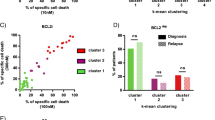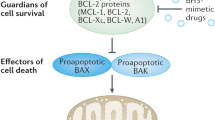Abstract
Disruption of pathways leading to programmed cell death plays a major role in most malignancies, including multiple myeloma (MM). ABT-737 is a BH3 mimetic small-molecule inhibitor that binds with high affinity to Bcl-2 and Bcl-xL, preventing the sequestration of proapoptotic molecules and shifting the cell survival/apoptosis balance toward apoptosis induction. In this study, we show that ABT-737 is cytotoxic to MM cell lines, including those resistant to conventional therapies, and primary tumor cells. Flow cytometric analysis of intracellular levels of Bcl-2 family proteins demonstrates a clear inversion of the Bax/Bcl-2 ratio leading to induction of apoptosis. Activation of the mitochondrial apoptosis pathway was indicated by mitochondrial membrane depolarization and caspase cleavage. Additionally, several signaling pathways known to be important for MM cell survival are disrupted following treatment with ABT-737. The impact of ABT-737 on survival could not be overcome by the addition of interleukin-6, vascular endothelial growth factor or insulin-like growth factor, suggesting that ABT-737 may be effective in preventing the growth and survival signals provided by the microenvironment. These data indicate that therapies targeting apoptotic pathways may be effective in MM treatment and warrant clinical evaluation of ABT-737 and similar drugs alone or in combination with other agents in the setting of MM.
This is a preview of subscription content, access via your institution
Access options
Subscribe to this journal
Receive 12 print issues and online access
$259.00 per year
only $21.58 per issue
Buy this article
- Purchase on Springer Link
- Instant access to full article PDF
Prices may be subject to local taxes which are calculated during checkout






Similar content being viewed by others
References
Kyle RA, Rajkumar SV . Multiple myeloma. N Engl J Med 2004; 351: 1860–1873.
Witzig TE, Dhodapkar MV, Kyle RA, Greipp PR . Quantitation of circulating peripheral blood plasma cells and their relationship to disease activity in patients with multiple myeloma. Cancer 1993; 72: 108–113.
Rajkumar SV, Kyle RA . Multiple myeloma: diagnosis and treatment. Mayo Clin Proc 2005; 80: 1371–1382.
Greipp PR, Witzig TE, Gonchoroff NJ, Habermann TM, Katzmann JA, O'Fallon WM et al. Immunofluorescence labeling indices in myeloma and related monoclonal gammopathies. Mayo Clin Proc 1987; 62: 969–977.
Witzig TE, Timm M, Larson D, Therneau T, Greipp PR . Measurement of apoptosis and proliferation of bone marrow plasma cells in patients with plasma cell proliferative disorders. Br J Haematol 1999; 104: 131–137.
Sangfelt O, Osterborg A, Grander D, Anderbring E, Ost A, Mellstedt H et al. Response to interferon therapy in patients with multiple myeloma correlates with expression of the Bcl-2 oncoprotein. Int J Cancer 1995; 63: 190–192.
Ong F, van Nieuwkoop JA, de Groot-Swings GM, Hermans J, Harvey MS, Kluin PM et al. Bcl-2 protein expression is not related to short survival in multiple myeloma. Leukemia 1995; 9: 1282–1284.
Renner S, Weisz J, Krajewski S, Krajewska M, Reed JC, Lichtenstein A . Expression of BAX in plasma cell dyscrasias. Clin Cancer Res 2000; 6: 2371–2380.
Feinman R, Koury J, Thames M, Barlogie B, Epstein J, Siegel DS . Role of NF-kappaB in the rescue of multiple myeloma cells from glucocorticoid-induced apoptosis by bcl-2. Blood 1999; 93: 3044–3052.
Tu Y, Xu FH, Liu J, Vescio R, Berenson J, Fady C et al. Upregulated expression of BCL-2 in multiple myeloma cells induced by exposure to doxorubicin, etoposide, and hydrogen peroxide. Blood 1996; 88: 1805–1812.
Panaretakis T, Pokrovskaja K, Shoshan MC, Grander D . Activation of Bak, Bax, and BH3-only proteins in the apoptotic response to doxorubicin. J Biol Chem 2002; 277: 44317–44326.
Mitsiades N, Mitsiades CS, Poulaki V, Chauhan D, Fanourakis G, Gu X et al. Molecular sequelae of proteasome inhibition in human multiple myeloma cells. Proc Natl Acad Sci USA 2002; 99: 14374–14379.
Oshiro MM, Landowski TH, Catlett-Falcone R, Hazlehurst LA, Huang M, Jove R et al. Inhibition of JAK kinase activity enhances Fas-mediated apoptosis but reduces cytotoxic activity of topoisomerase II inhibitors in U266 myeloma cells. Clin Cancer Res 2001; 7: 4262–4271.
Tu Y, Renner S, Xu F, Fleishman A, Taylor J, Weisz J et al. BCL-X expression in multiple myeloma: possible indicator of chemoresistance. Cancer Res 1998; 58: 256–262.
Strasser A, Whittingham S, Vaux DL, Bath ML, Adams JM, Cory S et al. Enforced BCL2 expression in B-lymphoid cells prolongs antibody responses and elicits autoimmune disease. Proc Natl Acad Sci USA 1991; 88: 8661–8665.
Linden M, Kirchhof N, Carlson C, Van Ness B . Targeted overexpression of Bcl-XL in B-lymphoid cells results in lymphoproliferative disease and plasma cell malignancies. Blood 2004; 103: 2779–2786.
Oltersdorf T, Elmore SW, Shoemaker AR, Armstrong RC, Augeri DJ, Belli BA et al. An inhibitor of Bcl-2 family proteins induces regression of solid tumours. Nature 2005; 435: 677–681.
Cory S, Adams JM . Killing cancer cells by flipping the Bcl-2/Bax switch. Cancer Cell 2005; 8: 5–6.
Kumar S, Raje N, Hideshima T, Ishitsuka K, Roccaro A, Shiraishi N et al. Antimyeloma activity of two novel N-substituted and tetraflourinated thalidomide analogs. Leukemia 2005; 19: 1253–1261.
Raje N, Kumar S, Hideshima T, Ishitsuka K, Chauhan D, Mitsiades CS et al. Combination of the mTOR inhibitor rapamycin and revlimid™ (CC-5013) has synergistic activity in multiple myeloma (MM). Blood 2004; 13: 4188–4193.
Chou TC, Talalay P . Quantitative analysis of dose–effect relationships: the combined effects of multiple drugs or enzyme inhibitors. Adv Enzyme Regul 1984; 22: 27–55.
Anderson KC, Dalton WS . Synopsis of a research roundtable presented on cell signaling in myeloma: regulation of growth and apoptosis – opportunities for new drug discovery. Mol Cancer Ther 2002; 1: 1361–1365.
Chauhan D, Anderson KC . Apoptosis in multiple myeloma: therapeutic implications. Apoptosis 2001; 6: 47–55.
Yang HH, Ma MH, Vescio RA, Berenson JR . Overcoming drug resistance in multiple myeloma: the emergence of therapeutic approaches to induce apoptosis. J Clin Oncol 2003; 21: 4239–4247.
van de Donk NW, Kamphuis MM, van Dijk M, Borst HP, Bloem AC, Lokhorst HM . Chemosensitization of myeloma plasma cells by an antisense-mediated downregulation of Bcl-2 protein. Leukemia 2003; 17: 211–219.
Derenne S, Monia B, Dean NM, Taylor JK, Rapp MJ, Harousseau JL et al. Antisense strategy shows that Mcl-1 rather than Bcl-2 or Bcl-x(L) is an essential survival protein of human myeloma cells. Blood 2002; 100: 194–199.
Wuilleme-Toumi S, Robillard N, Gomez P, Moreau P, Le Gouill S, Avet-Loiseau H et al. Mcl-1 is overexpressed in multiple myeloma and associated with relapse and shorter survival. Leukemia 2005; 19: 1248–1252.
Witters LM, Crispino J, Fraterrigo T, Green J, Lipton A . Effect of the combination of docetaxel, zoledronic acid, and a COX-2 inhibitor on the growth of human breast cancer cell lines. Am J Clin Oncol 2003; 26: S92–S97.
Pei XY, Dai Y, Grant S . Synergistic induction of oxidative injury and apoptosis in human multiple myeloma cells by the proteasome inhibitor bortezomib and histone deacetylase inhibitors. Clin Cancer Res 2004; 10: 3839–3852.
Pei XY, Dai Y, Grant S . The proteasome inhibitor bortezomib promotes mitochondrial injury and apoptosis induced by the small molecule Bcl-2 inhibitor HA14-1 in multiple myeloma cells. Leukemia 2003; 17: 2036–2045.
Shuker SB, Hajduk PJ, Meadows RP, Fesik SW . Discovering high-affinity ligands for proteins: SAR by NMR. Science 1996; 274: 1531–1534.
Brocke-Heidrich K, Kretzschmar AK, Pfeifer G, Henze C, Loffler D, Koczan D et al. Interleukin-6-dependent gene expression profiles in multiple myeloma INA-6 cells reveal a Bcl-2 family-independent survival pathway closely associated with Stat3 activation. Blood 2004; 103: 242–251.
Le Gouill S, Podar K, Harousseau JL, Anderson KC . Mcl-1 regulation and its role in multiple myeloma. Cell Cycle 2004; 3: 1259–1262.
Jourdan M, Veyrune JL, Vos JD, Redal N, Couderc G, Klein B . A major role for Mcl-1 antiapoptotic protein in the IL-6-induced survival of human myeloma cells. Oncogene 2003; 22: 2950–2959.
Zhang B, Gojo I, Fenton RG . Myeloid cell factor-1 is a critical survival factor for multiple myeloma. Blood 2002; 99: 1885–1893.
Kumar S, Rajkumar SV, Kimlinger T, Greipp PR, Witzig TE . CD45 expression by bone marrow plasma cells in multiple myeloma: clinical and biological correlations. Leukemia 2005; 19: 1466–1470.
Moreau P, Robillard N, Avet-Loiseau H, Pineau D, Morineau N, Milpied N et al. Patients with CD45 negative multiple myeloma receiving high-dose therapy have a shorter survival than those with CD45 positive multiple myeloma. Haematologica 2004; 89: 547–551.
Bataille R, Robillard N, Pellat-Deceunynck C, Amiot M . A cellular model for myeloma cell growth and maturation based on an intraclonal CD45 hierarchy. Immunol Rev 2003; 194: 105–111.
Gomez-Bougie P, Oliver L, Le Gouill S, Bataille R, Amiot M . Melphalan-induced apoptosis in multiple myeloma cells is associated with a cleavage of Mcl-1 and Bim and a decrease in the Mcl-1/Bim complex. Oncogene 2005; 24: 8076–8079.
Le Gouill S, Podar K, Harousseau JL, Anderson KC . Mcl-1 regulation and its role in multiple myeloma. Cell Cycle 2004; 3: 1259–1262.
Acknowledgements
We acknowledge Roberta DeGoey and Christy Finke for their assistance with processing of tumor cells and all of the patients who provided us with the tumor samples. SK is supported in part by a CR20 Award (Mayo Foundation), Mayo Clinic Hematological Malignancies Program and Career Development Award from P50 CA 100707.
Author information
Authors and Affiliations
Corresponding author
Rights and permissions
About this article
Cite this article
Kline, M., Rajkumar, S., Timm, M. et al. ABT-737, an inhibitor of Bcl-2 family proteins, is a potent inducer of apoptosis in multiple myeloma cells. Leukemia 21, 1549–1560 (2007). https://doi.org/10.1038/sj.leu.2404719
Received:
Revised:
Accepted:
Published:
Issue Date:
DOI: https://doi.org/10.1038/sj.leu.2404719
Keywords
This article is cited by
-
Single-molecule fingerprinting of protein-drug interaction using a funneled biological nanopore
Nature Communications (2023)
-
The application of BH3 mimetics in myeloid leukemias
Cell Death & Disease (2021)
-
Age-related injury responses of human oligodendrocytes to metabolic insults: link to BCL-2 and autophagy pathways
Communications Biology (2021)
-
Targeting BCL-2 in B-cell malignancies and overcoming therapeutic resistance
Cell Death & Disease (2020)
-
Deep profiling of apoptotic pathways with mass cytometry identifies a synergistic drug combination for killing myeloma cells
Cell Death & Differentiation (2020)



